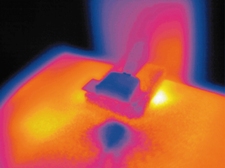Self-Cooling Microchips
As computer chips are crammed with more and more transistors, they run hotter, and traditional cooling mechanisms–heat sinks and fans–are having trouble keeping up. But future chips might cool themselves with a special gadget that uses ionized air and an electric field to create a tiny breeze. In a so-called ion pump, a high voltage across two electrodes strips electrons from molecules of oxygen and nitrogen in the air, creating positively charged ions. These ions flow to the negatively charged electrode, dragging along surrounding air molecules and cooling the chip. Researchers from Intel, the University of Washington Seattle, and Kronos Advanced Technologies of Redmond, WA, say a prototype can cool a two-square-millimeter spot on a surface by 25 ºC. Since the ion pump is made from silicon, it can be constructed as part of the chip-making process. Project leader Alex Mamishev, an electrical engineer at the University of Washington, says he expects the technology to be incorporated into commercial chips within two years.

Keep Reading
Most Popular
Large language models can do jaw-dropping things. But nobody knows exactly why.
And that's a problem. Figuring it out is one of the biggest scientific puzzles of our time and a crucial step towards controlling more powerful future models.
The problem with plug-in hybrids? Their drivers.
Plug-in hybrids are often sold as a transition to EVs, but new data from Europe shows we’re still underestimating the emissions they produce.
Google DeepMind’s new generative model makes Super Mario–like games from scratch
Genie learns how to control games by watching hours and hours of video. It could help train next-gen robots too.
How scientists traced a mysterious covid case back to six toilets
When wastewater surveillance turns into a hunt for a single infected individual, the ethics get tricky.
Stay connected
Get the latest updates from
MIT Technology Review
Discover special offers, top stories, upcoming events, and more.